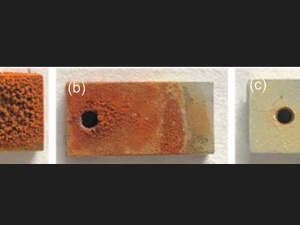Real-time Corrosion Monitoring of Aluminium Alloys Under Chloride-contaminated Atmospheric Conditions
Abstract
In this study, the use of electrical resistance (ER) sensors to monitor the corrosion of Al94Cu6 alloy is assessed and compared with 2024-T3 coupons. Under uniform corrosion, a good correlation was found between the ER sensors and mass loss on coupons. Three different chloride depositions are studied: (i) pre-contamination with dry/wet cycles, (ii) Volvo standard accelerated corrosion test and (iii) neutral salt spray test. The obtained results show good reproducibility of the ER sensors under all tested conditions. This suggests that ER sensors more levelled the effect of localised corrosion through a large surface evaluation compared with cross-sections. The corrosion thickness obtained with the ER sensors does not correspond to the mean depth obtained by cross-sections. This can be explained by the distribution and size of the localised corrosion events according to a finite element model proposed. The ER method allows obtaining useful real-time corrosion data for the understanding of the corrosion mechanisms and the development of accelerated tests. The chloride concentration, the frequency of salt application and wet/dry cycles have a strong influence on the corrosion rate of aluminium alloys.
Full open access article:
Source: Preview Image: restyler/Getty Images



